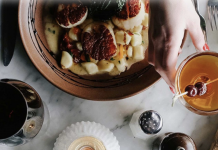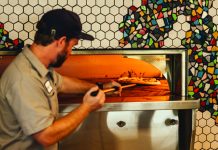Shortly after this last blast of snow melts, forage season will be upon us. Minnesota has a bevy of wild plants that can be collected and consumed, starting early in spring with morels and wild asparagus, until late fall when chicken of the woods mushrooms are at their tastiest. Whether you want to forage for yourself or enjoy the spoils of another’s forage, there are plenty of opportunities to chow down on the best of Minnesota’s wild side.
One is Slow Food Minnesota’s annual Where the Wild Things Are spring foraging dinner. Tickets are now on sale. The event, featuring tours, workshops, and a dinner, will take place on Sunday, May 19, from 11 a.m. to 5 p.m., at Andy Cotter and Irene Genelin’s York Farm in Hutchinson, Minn.
Slow Food Minnesota will serve hors d’oeuvres while the tours are underway, for attendees who would rather socialize. Later on, they will serve a foraged dinner buffet with wine and beer. Prepared by Craig Sharp and Tracy LeTourneau of Terra Waconia in Waconia, Minn., the meal will incorporate foraged foods, wine, and other beverages. According to Slow Food Minnesota Vice President Jane Rosemarin, the foraged foods will likely include foraged mushrooms, asparagus, and greens like garlic mustard, lamb tongue, chickweed, nettles, and ramps. The program also includes a variety of workshops and walks on ecology, beekeeping, foraging, insects and birds, and more.
“Starting right around 11 a.m., we start tours and workshops while we’re at the farm. We’ll have farmers from York Farm and Loon Organics, experts from the University of Minnesota, and representatives from the DNR share information about foraging and farming ecology,” said Rosemarin.
Tickets are $40 for Slow Food members and $50 for non-members. Children 12 and under are free. Rosemarin says the event usually sells out by May and usually has about 150 attendees, including herself.
“Foraged food has fresh flavors that you don’t find anywhere else,” said Rosemarin. “It makes you feel in touch with the earth and with spring. So many things that are around us are edible and have wonderful, bright flavors. I always look at plants differently after this event—I start seeing food on the ground everywhere.”
If you’re unfamiliar, foraged foods are wild, edible plants or plant products that have been collected for consumption. Foraging can be as simple as gathering wild raspberries or nibbling on dandelion greens, or as complex as hunting for morels in spring or making maple syrup. Rosemarin recommends Trout Caviar: Recipes from a Northern Forager for practical tips and recipes about the wild foods of our streams and forests.
Stephen Saupe, from the College of St. Benedict/St. John’s University Biology Department in Collegeville, Minn., offers an online resource of practical advice (PDF).
Here’s my summarized version of his resource:
- Many wild plants are edible.
- Evaluate the credibility of your references/resources. Be cautious. Many books simply repeat information in other sources without checking. And, even experts make mistakes.
- Do NOT eat any plant that you cannot positively identify. There are many excellent guides to edible plants and plant identification.
- Learn to recognize common poisonous plants.
- Avoid eating members of some plant families (groups) – e.g., lilies, buttercups.
- Do not assume that a plant related to an edible plant is edible. For example, the death camass is in the same family as wild leeks, which are edible.
- Watch out for poisonous plants that look like edible plants. In other words, learn to recognize poisonous look-alikes.
- Sample new species sparingly—check for allergic reactions and/or toxicity.
- Do not serve wild plants to anyone without his/her knowledge.
- There are no “Rules of Thumb” to determine if a particular plant is edible.
- Ignore folk tales that supposedly “prove” a plant is edible. For example, many plants that animals eat with impunity are poisonous to humans. Furthermore, a penny rarely turns black when cooked in the same pot as a poisonous plant.
- Do not over-collect edible wild plants. Use the 5% rule to guide your collecting—take no more than 1 in 20 plants. Never collect rare or endangered species (except in an emergency).
- Do not expect wild edibles to substitute or taste like common foods. Each plant should be judged on its own merits.
- Pick and use plant materials in their prime condition.
- Pick the plant in the appropriate season. For example, some plants are edible in the spring but not later in the growing season (e.g., milkweed, rhubarb)
- Prepare the appropriate part of the plant. In some cases, certain parts of the plant are edible, while other parts are not (e.g., apple seeds contain HCN; roots may often be poisonous while leaves are edible; mayapple fruit is edible but the vegetative parts of the plant are toxic).
- Some “edible” plants must be processed to render them non-toxic. Some “edible” plants are only edible after they are cooked (e.g., milkweed, marsh marigold) or dried for significant periods (e.g., Jack-in-pulpit).
- Some “edible” plants are only safe in small doses but are poisonous if eaten in large quantity (e.g.,cassava produces lots of HCN).
- Be aware that some plants are eaten with impunity by certain ethnic groups but may be poisonous to others (e.g., Hmong – black nightshade).
- Use caution when collecting plants along heavily traveled roadsides or areas likely to be polluted.
- Wash wild plants before eating.
- Prepare wild foods with the same care that you would give traditional foods.






